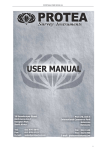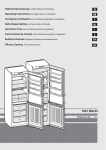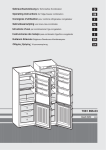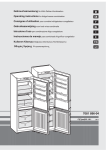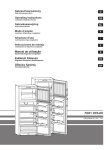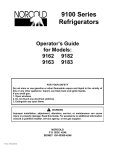Download Liebherr CPESF4023 Fridge Freezer in Stainless
Transcript
Gebrauchsanweisung für Kühl-Gefrier-Kombination
Operating instructions for fridge-freezer combination
Consignes d'utilisation pour combiné réfrigérateur-congélateur
Gebruiksaanwijzing voor koel-vries-combinatie
Istruzione d'uso per combinazione frigo-congelatore
Instrucciones de manejo para combinado frigorífico-congelador
Kullaným Kýlavuzu Soðutucu-Dondurucu-Kombinasyonu
Οδηγίες Χρήσης Ψυγειοκαταψύκτης
GR
7081 896-04
C(esf) 35../40..
4510
1 The appliance at a glance
Operating controls, fig. A1
1 On/Off button, fridge section
2*Ventilation button
3 Adjustment button, fridge section
4 Temperature display, fridge section
5 Temperature display, freezer section
6Adjustment button, freezer section
7 Superfrost button
8 Alarm button
9 On/Off button, freezer section
W By moving the bottle and can holder, you can prevent bottles
from tipping over when the door is opened and closed. The
holder can be removed for cleaning.
- fig. A2: The holder slides and releases left or right along the
door stops.
W You can remove all door racks for cleaning, fig. A2: lift rack
and pull forwards.
W The shelves* can be adjusted according to height of frozen
food, fig. A4.
- Lift the shelf, slide forwards and remove.
- Always insert shelves with the raised edge at the back pointing upwards, otherwise food may freeze onto the rear wall.
W Removing drawers: Pull forward until the drawer stops and lift out, fig. A3.
W Fig. A5: If you need space for large bottles and containers,
then simply push the front half of
glass shelf 1 back. For cleaning, the holder 2 can be used to
remove the half glass shelves.
Rating plate specifications fig. A6
1 Appliance designation
2 Service number
3 Appliance number
4 Freezing capacity ... kg/24hrs.
Description of appliance and equipment, fig. A
Refrigerator compartment, approx. 5 0C
Operating controls
Ceiling lighting
Egg tray
Butter stop
Adjustable storage shelves
Adjustable door racks
Defrost drain
Bottle shelf
Adjustable bottle and can holder
Door rack for large bottles
Coldest zone of the refrigerator compartment, for sensitive and
perishable foodstuffs
Vegetable, salad and fruit bins
Rating plate
Freezer compartment, approx. -18 0C
Information system*
VarioSpace*
High drawers
Ice-cube tray*
Adjustable-height feet at front, transport castors at back
10
* depending on model and options
Congratulations on your purchase. Your appliance offers you all the advantages of modern refrigeration technology, guaranteeing you high quality, a long service life and high reliability.
The features on your appliance have been designed to ensure maximum convenience - day in, day out.
This appliance has been manufactured with recyclable materials using an environmentally friendly
process, so together you and we are making an active contribution to the preservation of our environment.
To familiarise yourself with all the advantages your new appliance has to offer, please read the information contained in these operating instructions carefully.
We wish you much pleasure with your new appliance.
Contents
Page
Operating instructions
1 The appliance at a glance........................................ 10
Contents.................................................................... 11
Information system.................................................... 11
Safety regulations..................................................... 11
Saving energy........................................................... 11
2 Safety instructions and warnings.......................... 12
Disposal notes........................................................... 12
Technical safety......................................................... 12
Safety during use...................................................... 12
Setting up.................................................................. 12
Connecting to the mains........................................... 12
3 Putting into operation and controls....................... 13
Switching the appliance on and off............................ 13
Adjusting the temperature.......................................... 13
Temperature display.................................................. 13
Temperature alarm.................................................... 13
Switching the temperature alarm to mute...................... 13
4 Refrigerator compartment....................................... 14
Arrangement of food.................................................. 14
Refrigerating with fan*................................................ 14
Interior light................................................................ 14
5 Freezer compartment.............................................. 15
Making ice-cubes....................................................... 15
SuperFrost.................................................................. 15
Notes on freezing and storage................................... 15
6 Defrosting, cleaning................................................ 16
7 Troubleshooting....................................................... 16
Customer service and type plate.............................. 16
8 Instructions for installation and modification
Changing over door hinges........................................ 17
Insertion into row of kitchen units............................... 17
Keep these operating instructions in a safe place and pass
them on to the next owner, where applicable.
The operating instructions apply to several models. Differences may therefore occur.
§
Safety regulations
W The device is designed exclusively for the cooling
foodstuffs. The applicable statutory regulations are to be
observed in the event that the device is to be used for
commercial cooling of foodstuffs.
The device is not suitable for the storage and cooling of
drugs, blood plasma, laboratory preparations or similar
medicine-related materials and products as detailed in the
Medical Devices Directive 2007/47/EC. Improper use of
the device can cause the stored products stored in it to be
damaged or the items can be spoiled. In addition, the device is not suitable for operation in explosion-prone areas.
W The appliance is set to operate within specific ambient
temperature limits according to its climate rating. These
temperature limits should not be exceeded. The correct
climate rating for your appliance is indicated on the type
plate. This is explained as follows:
Climate rating
set for
ambient temperatures of
+10°C to
+16°C to
+16°C to
+16°C to
SN
N
ST
T
+32°C
+32°C
+38°C
+43°C
- The refrigerant circuit has been tested for leaks.
- The appliance complies with current safety regulations
and EC directives 2006/95/EC and 2004/108/EC.
Saving energy
- Always ensure good ventilation. Do not cover ventilation
openings or grille.
- Always keep fan louvres clear.
Information system*
- Do not place appliance in areas of direct sunlight or next to
Use frozen food within the recommended period.
a stove, heater or similar object.
The numbers between the symbols indicate the storage
- The energy consumption depends on the installation conperiod in months for different kinds of frozen foods.
ditions, e.g. the ambient temperature.
Storage times given are guide times for food frozen at home. - Keep the time the appliance is open to a minimum.
Whether or not the lower or upper value is applicable de- Store food logically.
pends on the food quality and how it was processed prior to - Ensure that all food is well packed and covered for storage.
freezing. The lower values always apply to food with a high
This will prevent frost from forming.
fat content.
- First cool warm food to room temperature before storing it.
The symbols have the following signification:
- Defrost frozen food in the refrigerator.
- If there is a thick layer of frost in the appliance: defrost the
appliance.
- Empty and switch off refrigerating
unit for longer vacation periods.
Accumulated dust increases the energy consumption:
- Once a year, dust the refrigerating
unit together with the metal grille of
the heat exchanger at the back of
the appliance.
Note
1
2
3
pre-cooked meals, ice-cream
fish, pork
vegetables, fruit
4
5
6
- Place food inside the appliance as shown in the diagram.
This allows the appliance to save energy during operation.
- Shelves, drawers and baskets are arranged for optimum
energy efficiency on delivery.
sausages, bread
mushrooms, game
poultry, beef/veal
* depending on model and options
11
2 Safety instructions and warnings
Disposal notes
Setting up
W When setting up/fitting ensure that the refrigerant circuit
The packaging is made of recyclable materials.
pipes are not damaged.
- Corrugated board/board
W Once in position, use a 10 spanner to adjust the feet so
- EPS moulded parts
that the appliance is level and does not wobble.
- Polythene sheets
WStandard EN 378 specifies that the room in which
you install your appliance must have a volume of 1 m3 per
- Polypropylene straps
8
g of R 600a refrigerant used in the appliance, so as to
W Keep packaging materials away from children avoid the formation of inflammable gas/air mixtures in the
polythene sheets and bags can cause suffocation!
room where the appliance is located in the event of a leak
W Please return the packaging to an official collection point.
in the refrigerant circuit. The quantity of refrigeYour old appliance: This contains some reusable
rant used in your appliance is indicated on the
materials and should be disposed of properly - not
type plate on the inside of the appliance.
simply with unsorted household refuse.
W Always position the appliance directly up against
W Discarded appliances should be disabled:
the wall.
Remove the plug, cut through the connection
W The ventilation grilles should not be obstruccable and render the catch unusable so that
ted. Please note the appendix concerning instalchildren cannot become trapped inside.
lation instructions.
W Condensation may form on the outside of the refrigerator/
W Ensure that the refrigerant circuit is not damaged
freezer during periods of high humidity.
when the appliance that is no longer needed is
Constant ventilation of the installation site is recommend.
taken away for disposal.
WDo not place heat-emitting appliances, e.g. microwave
W Details of the refrigerant can be found on the type plate.
oven, toaster, etc., on top of the refrigerator or freezer.
W Appliances which are no longer needed must be disposed of
in a professional and appropriate way, in accordance with W In order to avoid the risk of fire, do not place any burning
candles, lamps or other objects with open flames on the
the current local regulations and laws.
refrigerator/freezer.
W Fire hazard due to dampness!
Technical safety
If live parts or the mains lead become damp this may
W To prevent injury or damage to the unit, the appcause short circuits.
liance should only be transported wrapped and
- The appliance is designed for use in enclosed areas. Do
set up by two people.
not operate the appliance outdoors or in areas where it is
W The refrigerant R 600a is environmentally friendly but
exposed to splash water or damp conditions.
flammable.
WCAUTION! Risk of injury and danger of damage as a
W Do not damage the refrigerant circuit pipes. Splashes of
result of incorrect transport!
refrigerant can harm your eyes or ignite.
- Transport the appliance in a packed condition.
W If refrigerant escapes, remove all naked flames or sour- Transport the appliance upright.
ces of ignition in the vicinity of the leak, disconnect the
- Do not transport the appliance without assistance.
appliance from the mains and ventilate the area well.
W The appliance may be moved only when it is empty.
W In the event that the appliance is damaged, contact the
supplier immediately before connecting to the mains.
W To guarantee safe operation, ensure that the appliance
Connecting to the mains
is set up and connected as described in these operating
Power supply (AC) and voltage
instructions.
W In the event of a fault, disconnect the appliance from the
at the operating point must comply with the details on
mains: disconnect mains plug (do not pull on the connec- the rating plate, which is located on the inside left of
tion cable) or trigger or unscrew fuse.
the appliance, next to the vegetable bins.
W Any repairs and work on the appliance should only be
W Connect the appliance with a properly earthed fused
carried out by the customer service department, as unplug and socket only.
authorised work could prove highly dangerous for the
W The socket must be fused with a 10 A fuse or higher, it
user. The same applies to changing the mains power cable.
must be away from the rear of the appliance and must be
easily accessible.
Safety during use
W Do not connect the appliance to the supply with other
equipment using a distribution outlet - risk of overheating.
WDo not store explosives or sprays using combuW When removing the mains cable from the back of the appliance,
stible propellants such as butane, propane, penremove the cable holder as well so as to avoid vibration noise.
tane, etc. in the appliance. Electrical components might
cause leaking gas to ignite. You can identify such sprays
by the printed contents or a flame symbol.
W Only store high-percentage alcohol in tightly sealed,
The wires in the mains lead are coloured in accordance with
upright containers.
W Do not allow naked flames or ignition sources to enter the the following code:
green/yellow = earth,
appliance.
W Do not use electrical appliances inside the appliance (e.g. blue = neutral,
brown = live.
steam cleaners, heaters, ice makers, etc.).
W Do not stand on the plinth, drawers or doors or use them Warning! This appliance must be earthed.
Non-rewireable plugs BS 1363
to support anything else.
If this machine or appliance is fitted with a non-rewireable plug,
W This appliance is not intended for use by persons (incluthe following information applies: If the socket outlets are not
ding children) with reduced physical, sensory or mental
suitable for the plug supplied with this product, it must be cut
capabilities or lack of experience and knowledge unless
off and an appropriate plug fitted. The plug cut from the flexi-ble
they have been given initial supervision or instruction
concerning use of the appliance by a person responsible cord should be disposed of and on no account be inserted into
a 13 A socket elsewhere in the house (electric shock hazard).
for their safety. Children should be supervised to ensure
The fuse cover must be re-fitted when changing the fuse, and if
that they do not play with the appliance.
the fuse cover is lost the plug must not be used until a suitable
W Avoid prolonged skin contact with cold surfaces or chilreplacement is obtained. The colour of the correct replacement
led/frozen food. This could cause pain, numbness and
frostbite. In the case of prolonged skin contact, protective cover is that of the coloured insert in the base of the plug, or
the colour that is embossed in words on the base of the plug
measures should be taken, e.g. gloves should be worn.
W Do not consume food which has been stored for too long, (as applicable to the design of the plug fitted).
as it could cause food poisoning.
The correct rating of the replacement fuses that are ASTA
W Special-purpose lamps (incandescent lamps, LEDs,
approved to BS 1362 should be fitted. Replacement fuse covers
fluorescent tubes) in the appliance serve to illuminate the may be purchased from your local electrical suppliers, electriciappliance interior and are not suited for room illumination. ty showroom or approved service agent.
12
3 Putting into operation and controls
You are advised to clean the appliance before switching it on
for the first time (see "Cleaning").
Put the appliance into operation approximately 4 hours before loading with frozen food for the first time. Only insert
frozen food when the freezer compartment is cold.
Switching the appliance on and off Fig.
A1
Switching on: To switch on the entire appliance, you only
need to switch on the freezer section. The fridge section is
automatically switched on, too.
W Switching on the freezer section:
- Briefly press the On/Off button 9.
The temperature displays light up. The appliance is
switched on.
W Switching on the fridge section:
When the fridge section is switched on, the freezer section
is switched on, too.
- Briefly press the On/Off button 1.
The temperature displays light up. The fridge and freezer
sections are switched on.
Switching off
- To switch off the entire appliance you only need to switch
off the freezer section. The fridge section is automatically
switched off, too.
W Switching off the freezer section:
- Press the On/Off button 9 for approx. 2s.
The temperature displays are dark. The appliance is
switched off.
W Switching off the fridge section:
- Press the On/Off button 1.
The interior lighting is dark. The temperature display of
the fridge section is dark.
If only the fridge section is to be switched off, e.g. during
holiday periods, always make sure that: the temperature
display on the freezer sections remains lit.
Adjusting the temperature Fig. A1
W Fridge section:
The temperature depends on the following factors:
- The frequency of opening the door
- The room temperature of the installation location
- The type, temperature and quantity of the frozen food
Recommended temperature setting: 5 °C.
The temperature can be changed progressively. When
the setting 1 °C is reached, it begins again at 9 °C.
- Press the adjustment button 3until the LED of the
desired temperature lights up.
Note: Pressing the Up/Down button once activates the
nominal value adjustment.
By pressing the adjustment button for a long time, a colder
setting is adjusted within a small temperature range (e.g.:
between ``5`` and ``7``), but it is not visible on the display.
W Freezer section:
Recommended temperature setting: -18 °C.
The temperature can be changed progressively. When
the setting -32 °C is reached, it begins again at -15 °C.
- Press the freezer section adjustment button 6until the
LED of the desired temperature lights up.
Note: Pressing the Up/Down button once activates the
nominal value adjustment.
By pressing the adjustment button for a long time, a colder
setting is adjusted within a small temperature range (e.g.:
between ``-15°C`` and ``-18°C``), but it is not visible on the
display.
Temperature display
The following are displayed in normal mode:
- The set freezer temperature
- The set fridge temperature.
The display flashes:
- The temperature setting is being changed
- The temperature has risen by several degrees.
Temperature alarm
For the freezer section
When the freezer temperature is no longer cold enough, the
acoustic warning signal sounds.
At the same time, button 8flashes.
The following may be the cause of the temperature being
too high:
- Fresh hot food has been put in
- Too much warm air has got in while you were sorting out the freezer or removing items.
- There ahs been a longer power failure
- The appliance is faulty.
The acoustic warning signal is automatically shut off when
the temperature is cold enough again.
If the alarm condition remains, proceed according to the
chapter dealing with faults.
Note: If the temperature is not cold enough, food may go off.
- Check the quality of the food. Do not consume food that has gone off.
Switching the temperature alarm to mute
The acoustic warning signal can be switched to mute. When
the temperature is cold enough again, the alarm function
returns to active condition.
- Press button 8.
- The acoustic warning signal shuts off.
- The alarm button 8stops flashing. It goes out when the
temperature is cold enough again.
* depending on model and options
13
4 Refrigerator compartment
Arrangement of food
Due to the natural air circulation in the refrigerator compartment, different temperature ranges result, which are
beneficial for the storage of different foods. Just above the
vegetable bins and at the back of the refrigerator, the air is
colder, ideal for raw meat or cold meats; at the top front of
the compartment and in the door, the air is warmer, making
it ideal for cheese and for spreadable butter.
Notes on refrigerating
- Store food so that the air can circulate freely; do not place
items too close together. Do not cover the ventilator air
slots* on the rear wall - improtant for refrigerating capacity!
- Always keep foods which easily give off or take on odours
or flavours, and liquids, in closed containers or covered.
- Always store food which gives off or is sensitive to ethylene gases such as fruit, vegetables and salads separately or wrapped in order not to affect their storage life;
e.g. do not store tomatoes together with kiwis or cabbage.
Changing the interior lighting
Light-bulb specifications:
max. 25 W
Socket: E 14
The current and voltage types should agree with the
information on the type plate
WSwitch off the appliance. Remove the mains plug, or
trigger or remove the fuse.
WHold the lamp cover at the front according to the illustration,
and detach at the rear.
WReplace the bulb.
WRe-install the cover.
Refrigerating with fan*
You can quickly cool down large quantities of fresh food or
achieve a relatively even temperature distribution over all
storage surfaces using the fan.
Due to the enforced air circulation, the various
temperature ranges of normal operation are raised.
The following are recommended when cooling by circulating air:
- With high room temperature (above approx. 30 °C),
- With high humidity, e.g. on summer days.
Cooling by circulating air uses slightly more energy. To save
energy, the fan automatically switches off when the door is
opened.
Switching on the fan:
- press the fan button 2 (Fig. A1)
- the button lights up
- the fan is switched on.
Switching off the fan
- press the fan button 2 (Fig. A1)
- the fan button goes out
- the fan is switched off.
14
* depending on model and options
5 Freezer compartment
Making ice-cubes
W Suitable packing materials are conventional freezer
bags, reusable plastic, metal and aluminium containers.
W Do not allow fresh food to be frozen to come into contact
with food already frozen. Always insert packaging in a dry
condition to avoid packaging freezing together.
W Always provide packaging with date and contents and do
not exceed the recommended storage time of the frozen
food, in order to prevent reductions in quality.
WAlways package food which you freeze yourself in suitable portions for your household. So that the food freezes
SuperFrost
quickly through to the core, the following quantities per
The fresh foods should be frozen to the core as quickly as
package should not be exceeded:
possible and frozen foods already stored be given a "cold
- Fruit and vegetables up to 1 kg,
reserve". This is enabled by the SuperFrost
- meat up to 2.5 kg.
system. This is the best way of maintaining the nutritional
W After wasing and portioning, blanch vegetables (immerse
value, appearance and flavour of frozen foods.
in boiling water for 2-3 minutes, then remove and cool
W The maximum amount of fresh food which can be frozen
in cold water). If blanching with a steamer or microwave,
in 24 hours is shown on the rating plate ("Freezing capacobserve the relevant instructions).
ity ... kg/24h"), fig. A6, pos. 4. The maximum quantity of
W Do not salt or season food and blanched vegetables
frozen food varies according to model and climatic class.
before freezing. Only lightly salt and season other foods.
The intensity of flavour of certain seasonings changes.
W Do not freeze bottles and tins containing carbonated
Freezing with SuperFrost
beverages, as otherwise they may burst.
Fig. A1/7
You do not have to switch SuperFrost on:
W For storage: The individual storage tray can support
- when inserting already frozen foods,
max. 25 kg of frozen goods.
- when freezing up to approx. 2 kg of fresh food daily.
W VarioSpace: By removing the 2nd and 3rd draw and the
storage tray, you obtain the storage space for bulky goods
W Press SuperFrost button 7 briefly, so that the LED lights
equivalent to two drawer heights. Poultry, meat, large
up.
game pieces and tall baked goods can be frozen whole
- The freezing temperature decreases, the appliance works
and further prepared in one piece.
with the greatest possible freezing capacity.
W If you wish to use the max. holding
W With a smaller amount of food to be frozen, wait/precapacity, you can remove the drawers
freeze for approx 6 hours - normally sufficient, with the
and store the frozen goods directly on the
maximum quantity, see freezing capacity on rating plate,
storage trays.
approx. 24 hours.
- Removing drawers, fig. G1:
W Then insert the fresh food.
pull out to stop position and lift up at front.
- The SuperFrost function can be quit manually by briefly
- Removing storage tray, fig. G2:
pressing button 7, if not:
remove 2nd and 3rd drawer, lift storage
- SuperFrost switches off automatically after approximately
tray up at front and pull out.
65 hours.
To insert: simply push storage tray in,
- the SuperFrost button is dark
snap into position at front.
- the temperature range set for normal mode lights up in
W For defrosting, always only remove as much as will be
the temperature display.
needed immediately. Defrosted food should be used to
- the appliance continues in normal energy-saving mode.
prepare a meal as soon as possible.
W In order to reach the maximum freezer performance,
You can defrost frozen food:
warm food must be placed directly on the shelves, not in
- in the oven/fan-assisted oven
the drawers, or stored in direct contact to the inner side
- in the microwave
walls.
- at room temperature
- Defrosted flat meat and fish portions can be heated up.
- Vegetables can be prepared in a frozen state (at half
Notes on freezing and storage
cooking time as fresh vegetables).
W As a guideline for the storage time, the following applies to
various foodstuffs in the freezer compartment:
WFill the ice-cube tray* threequarters full with water and
freeze. The ice-cubes can be removed from the tray by twisting
or by holding upside down for a
short time under running water.
Ice cream
Sausage, ham
Bread, cakes and pastries
Game, pork
Fish, oily
Fish, lean
Cheese
Poultry, beef
Vegetables, fruit
2 to 6 months
2 to 6 months
2 to 6 months
6 to 10 months
2 to 6 months
6 to 12 months
2 to 6 months
6 to 12 months
Cold-storage accumulators*
The cold-storage accumulators provided prevent the temperature in the freezer from rising too quickly
in the event of a power failure, thus
preserving the quality of the food.
To ensure maximum storage time
in the event of a power failure,
place the cold-storage accumulators in the top-most freezer drawer on
top of the food.
6 to 12 months
* depending on model and options
15
6 Defrosting, cleaning
7 Troubleshooting
Defrosting
The refrigerator compartment
defrosts automatically. The defrost water is evaporated by the heat from the compressor; drops of water
on the rear wall are perfectly normal.
W Ensure that the defrost water can flow freely through the
drain hole in the rear wall (arrow in fig. A).
The freezer compartment
Your appliance is designed and manufactured in such a way
as to provide fault.free operation and a long service life.
Nevertheless, if a fault should occur during operation, please check whether the fault is due to incorrect operation. In
this case we have to charge you for any costs incurred also
within the warranty period.
You can eliminate the following faults yourself by checking
the possible causes:
Fault
possible cause and remedy
W To defrost, switch off the appliance:
- Disconnect the appliance from the mains.
W If possible, put the frozen goods in the freezer drawer,
wrap in newspaper or a blanket and store in a cool place.
W To speed up the defrosting process place a saucepan of
hot but not boiling water on one of the middle shelves.
Do not use electric heaters or steam clean-ers, defrosting sprays or naked flames for defrosting nor any metal
objects for removing the ice. Risk of injury and damage!
W Leave the appliance door open when defrosting.
After defrosting, mop up the remaining water with a
sponge or cloth and clean the appliance.
Appliance not working, display is unlit
- Is the appliance switched on properly?
- Is the mains plug properly inserted in the socket?
- Is the socket fuse intact?
The interior light does not come on
- Is the refrigerator compartment switched on?
- Was the door open for longer than 15 min.?
- The bulb is defective. Change the bulb as described in
"Interior light".
Loud running noise
- Is the appliance standing firmly on the floor, or does the
compressor cause nearby items of furniture or objects to
vibrate?
If necessary, move the appliance slightly, align by adjuCleaning
sting the adjustable feet, or move bottles and containers
W Before cleaning, always switch off the appliapart.
ance. Disconnect from the mains or un-screw
- The following are normal:
or switch off the fuse.
Flow noises, bubbling or dripping, coming from the
coolant in the refrigerating circuit.
W Clean the outer walls, inside and equipment by
hand with lukewarm water and a little detergent. Because A soft clicking sound, this always occurs when the refrigeration unit (the motor) switches on or off automatically.
of the risk of injury and damage to the appliance, steam
Motor noise; this will be slightly louder for a brief period
cleaning equipment should not be used.
when the refrigeration unit switches on. When SuperFrost
W Do not use abrasive sponges or scourers, do not use
is switched on, fresh food is inserted, or when the door is
concentrated cleaning agents and never use cleaning
open for a long time, the refrigerating capacity increases
agents containing sand, chloride or acid or chemical solvents, as
automatically. A deep humming sound occurs due to air
these would damage the surfaces and could cause corrosion.
flow noises of the fan.
W We recommend using a soft cloth and an all-purpose
Alarm sounds, red visual warning LED flashes,
cleaner with a neutral pH value. Only use food safe cleantemperature is not low enough
ing materials inside the appliance.
- Were too large quantities of fresh food inserted without
W For stainless-steel appliances:
SuperFrost? (see section "SuperFrost")
- Clean the side panels and door surfaces with a clean and
- Does the door close properly?
soft cloth. If necessary, use a moist cloth (water + detergent). - Is the appliance sufficiently well ventilated?
Alternatively, use a micro-fibre cloth.
Clear ventilation grilles if necessary.
W Ensure that no cleaning water penetrates into the electri- - Is the ambient temperature too hot? (See "Safety regulacal components, drain gulley* or ventilation grilles.
tions")
- Has the appliance been opened too often or left open too
Wipe the appliance dry.
long?
W Do not damage or remove the type plate on the inside of
the appliance. It is very important for servicing purposes. - If applicable, wait until the appliance reaches the required
temperature itself.
W Clean the drain hole on the rear
The compressor will continue to run for a while
wall above the vegetable bins
- On energy saving models, this is caused by the funcfrequently, fig. A, arrow.
tions and is perfectly normal. When less refrigeration is
If necessary, clean with a thin
required, the VCC compressor switches to a low speed.
object, e.g. a cotton swab or
It will then be running almost constantly, but it does save
similar.
energy.
The inverter regularly flashes every 15 seconds*.
W Ensure that none of the wires or other components are
- The inverter is equipped wth a diagnostic LED.
dislodged, bent or damaged.
- The flashing is normal.
W Then connect/switch on the appliance.
If the appliance is to be left switched off for any length of
time, empty the appliance, disconnect from the mains, clean as
described above and leave the door open so as to avoid odours.
16
Customer service and type plate
If none of the above causes applies and you cannot
eliminate the fault yourself or if more than one LED
is flashing, please contact your nearest after-sales service
point (see list attached). Please
state the
appliance designation 1,
service number 2,
appliance number 3
of the rating plate (see fig.),
and which LED displays are
flashing so as to ensure rapid,
accurate servicing. The rating
plate is located inside the appliance on the left-hand side.
Keep the appliance closed until the after-sales service tech
nician arrives in order to prevent further loss of refrigeration.
* depending on model and options
8 Instructions for installation and modification
Do not install the appliance side-by-side with another refrigerator or freezer. This is important to prevent condensation
and consequential damage from it.
Transferring the handles
On both the upper and lower door:
- Transfer the spring clamp Fig. 5 (31): Depress the latch
nose and pull the spring clamp off over it.
- Slide the spring clamp into place on the new hinge side
until it clicks into place.
- Lift the stopper Fig. 6 (30) out of the door bearing bush
and transfer it.
- Detach door handle Fig. 6 (32), stopper Fig. 6 (33) and
pressure plates Fig. 6 (34) and transfer to the opposite
side.
- When fitting the pressure plates on the opposite side,
make sure they snap properly into place*.
You can change over the door hinges if necessary.
Ensure that the following tools are to hand:
- Torx® 25
- Torx® 15
- Screwdriver
- Cordless screwdriver, if necessary
- Second person for fitting work, if needed
- Accompanying Allen key size 2
Fitting the lower door
- Place the lower door from above onto the lower bearing
pin.
- Close the door.
- Place the plastic cap Fig. 2 (10) back onto the middle turn
hinge Fig. 2 (13).
- Place the middle bearing pin Fig. 2 (11) in the lower door,
on the new hinge side, through the middle turn hinge Fig.
2 (13).
Before reading, please fold out and
refer to the illustrated back page.
The external dimensions of the appliance can be seen on
fig. S.
Changing over the door hinges
Detaching the upper door
- Close the upper door.
- Pull off the cover Fig. 1 (1) forwards and upwards.
- Lift off the cover Fig. 1 (2).
CAUTION
Risk of injury if the door tips!
- Take good hold of the door.
- Set down the door carefully.
- Unscrew the upper turn hinge Fig. 1 (3) (2x Torx® 25)
Fig. 1 (4) and lift it off.
- Lift up the upper door and set it aside.
Detaching the lower door
- Close the lower door.
- Draw the middle bearing pin Fig. 2 (11) out of the turn
hinge and lower door.
- Remove the plastic cap Fig. 2 (10).
CAUTION
Risk of injury if the door tips!
- Take good hold of the door.
- Set down the door carefully.
- Open the lower door.
- Unscrew the middle turn hinge (2x Torx® 25). Fig. 2 (13)
- Lift up the door and set it aside.
Transferring the middle bearing elements
- Carefully detach the cover panel Fig. 2 (12).
- Turn the middle turn hinge Fig. 2 (13) with the washer Fig.
2 (14) through 180° and screw it firmly into place on the
new hinge side (with 4 Nm).
- Turn the cover panel Fig. 2 (12) through 180° and snap it
into place again on the new handle side.
Transferring the lower
bearing elements
For appliances without
height adjustment
- Lift out the bearing pin
Fig. 3 (22) together with
washer Fig. 3 (23) and foot
Fig. 3 (24).
- Lift off the stopper Fig. 3 (21).
- Unscrew Fig. 3 (26) the turn hinge Fig. 3 (25).
- Unscrew Fig. 3 (29) the bearing element Fig. 3 (28), transfer it to the opposite location hole of the turn hinge and
screw it firmly into place.
- Carefully lift off the cover on the handle side Fig. 3 (27)
and transfer it to the opposite side.
- Screw the turn hinge Fig. 3 (25) firmly into place on the
new hinge side, possibly using a cordless screwdriver
(with 4 Nm).
- Re-insert the stopper Fig. 3 (21) into the other hole.
- Re-insert the bearing pin Fig. 3 (22) together with washer
and foot. In so doing, pay attention that the locating lug
points backwards
Fitting the upper door
- Place the upper door on the middle bearing pin Fig. 2 (11).
- Insert the upper turn hinge Fig. 1 (3) in the door on the
new hinge side.
- Screw the upper turn hinge firmly into place (with 4 Nm)
(2x Torx® 25) Fig. 1 (4). Possibly make preliminary holes
with a bradawl or use a cordless screwdriver.
- Apply the cover Fig. 1 (1) and cover Fig. 1 (2) to the opposite side from the outside and snap them into place.
Aligning the doors
- If necessary, align the doors to the appliance housing by
way of the two oblong holes in the bottom turn hinge and
middle turn hinge Fig. 2 (13). To do so, unscrew the middle screw in the bottom turn hinge.
WARNING
Risk of injury due to the door dropping out!
If the bearing parts are not screwed into place firmly enough,
the door may drop out. This may lead to severe injuries.
What is more, the door may not close and therefore the appliance may fail to cool properly.
- Screw the turn hinges firmly into place with 4 Nm.
- Check all of the screws and retighten if necessary.
Insertion into row of kitchen units
1top unit
3Kitchen cupboard
2refrigerator/freezer
4wall
Fig. U: The appliances can be installed in a row of kitchen
units. To adapt the height of the appliance to the surrounding
furniture a top unit 1 can be added.
When retrofitting with standard kitchen cabinets (max. depth
580 mm), the appliance can be set up directly next to the
kitchen cupboard Fig. U 3. The appliance door protrudes
34 mm at the side and 50 mm in the middle of the appliance
against the front panel of the kitchen cupboard. It can
therefore be opened and closed without any problems.
Important for ventilation:
- On the rear side of the top unit there must be a ventilation duct
of at least 50 mm depth along the entire width of the top unit.
- The area of ventilation underneath the ceiling must be at
least 300 cm².
- The larger the ventilation cross section, the more energy
the appliance will be able to save.
If the appliance is installed with the hinge side against a wall
Fig. U 4, the distance between the appliance and the wall
must be at least 36 mm. This corresponds with the handle
protrusion when the door is open.
All types and models are subject to continuous improvement
and the manufacturer therefore reserves the right to make
modifications in the shape, equipment and technology.
17
min. 2
300 cm
[mm]
[mm]
n.
mi
50
600
631
614
661
1176
0
1
63
60
0
606
0
58
637
1817/2011
2
10
3
U
4
Ca
.36
S










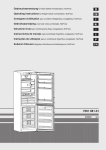

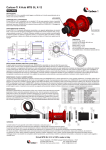
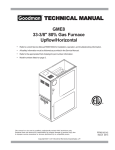
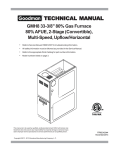
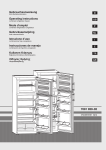
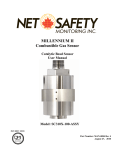
![PLAS A O ]-OR](http://vs1.manualzilla.com/store/data/005852706_1-5db0b7ed584537f0e62af161fb124638-150x150.png)
